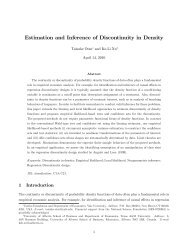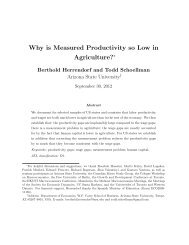<strong>and</strong> Gr ρZ ×w ∗f ∗ (·) is the USCO induced by Gr ρZ ×w ∗f ∗ ∈ P ρZ ×w ∗ f(Z × X), givenbyz → Gr ρZ ×w ∗f ∗ (z) := © x ∈ X :(z,x) ∈ Gr ρZ ×w ∗f ∗ª .Because the exterior AK-limit USCO, ψ ∞ ,is quasiminimal, [ψ ∞ ] ρZ -w ∗ = {η},<strong>and</strong> because Z is a Baire space <strong>and</strong> X is a metric space, we have by Lemma 7in Anguelov <strong>and</strong> Kalenda (2009) that ψ ∞ (·) is single-valued on a dense, open G δsubset D of Z. Also, because Z is locally convex, <strong>and</strong> hence locally connected, <strong>and</strong>because Grf n F ∗ for the sequence of ρ Z -w ∗ -continuous functions, {f n } n ,by→hρZ ×w ∗Theorem 3 in Hola (1987), we have for the induced USCO, z → F ∗ (z), thatF ∗ (·) isconnected-valued. Thus, F ∗ (·) is a CUSCO <strong>and</strong> thusF ∗ (z) ∈ C w ∗ f(X) for all z ∈ Z.Summarizing then, we have for Nash USCO, N ∈ U ρZ −w∗, an approximatingtriple,(η,f ∗ , {f n } n ) N ,such that for all z ∈ ZGr ρZ -w ∗f ∗ (z) =η(z) ⊆ F ∗ (z) ⊆ ψ ∞ (z), (59)where η(z) <strong>and</strong> F ∗ (z) are continua for each z <strong>and</strong> [ψ ∞ ] ρZ -w∗ = {η}. Butforz in theρ Z -dense, open G δ set D ⊂ Z we haveGr ρZ -w ∗f ∗ (z) =η(z) =F ∗ (z) =ψ ∞ (z). (60)6.5 MainResultonApproximationOur main results on the structure <strong>and</strong> properties of the induced CUSCO, F ∗ (·), arethe following:Theorem 16 (All USCOs with the 3M Property are approximable)Suppose assumptions [A-1] hold <strong>and</strong> let N ∈ U ρZ -w ∗ beaNashUSCOwithapproximatingtriple,(η,f ∗ , {f n } n ) N ,where η ∈ [N ] ρZ -w ∗, f ∗ ∈ QC ρZ -w ∗,<strong>and</strong>{f n } n ⊂ C ρZ -w∗(Z, X) are such that forall z ∈ Zf n (z) → f ∗ (z) ∈ η(z).w ∗If F ∗ ∈ h ρZ ×w ∗-Ls{Grf n } is any h ρZ ×w∗-limit point of the corresponding graph sequence,{Grf n } n ⊂ P ρZ ×w ∗ f(Z × X),with induced USCO, F ∗ (·), then the following statements are true:(1) For all z ∈ Z, F ∗ (z) ∈ C w ∗ f(X) is a strongly convex dendrite (locally connected<strong>and</strong> hereditarily unicoherent with unique segments).34
(2) For all z ∈ Z, F ∗ (z) is the unique, irreducible continuum about η(z) <strong>and</strong>F ∗ (z) ⊆ N (z).(3) For all z ∈ Z, F ∗ (z) is minimally essential for N (z) in C w ∗ f(X) -i.e.,F ∗ (z) ∈ M N (z) (C w ∗ f(X)).Proof. (1) Because Z is a locally connected, compact metric space, the connectednessof F ∗ (z) follows Theorem 3 in Hola (1987). Thus, we have F ∗ (z) ∈ C w ∗ f(X) for allz ∈ Z. Because the hyperspace of subcontinua, C w ∗ f(X), is a convex metric space(see Theorems 2 <strong>and</strong> 3 <strong>and</strong> Corollary 4 above), the fact that F ∗ (z) is a dendrite (i.e.,a locally connected, hereditarily unicoherent subcontinua) for all z is an immediateconsequence of Theorem 5 above. Moreover, by Whyburn (1942) (also see Charatonik<strong>and</strong> Charatonik, Theorem 1.3, 1998), all subcontinua of F ∗ (z) are dendrites. Thefact that all subcontinua of F ∗ (z) are also dendrites implies, by Theorem 2.5 of Duda(1962), that F ∗ (z) is strongly convex for all z.(2) We have by expression (59) that η(z) ⊆ F ∗ (z). We will show thatF ∗ (z) =κ(η(z)) := ∩ {M ∈ C w ∗ f(X) :η(z) ⊆ M} for all z ∈ Z,where κ(·) is the Goodykoontz (1977) mapping, continuous with respect to the Hausdorffmetric h w ∗ on P w ∗ f(X) because X is a dendrite (see expression 12), <strong>and</strong> wherefor each z ∈ Z, κ(η(z)) ∈ C w ∗ f(X) is the unique subcontinuum irreducible aboutη(z). Because F ∗ (z) ∈ C w ∗ f(X) <strong>and</strong> η(z) ⊆ F ∗ (z) for all z ∈ Z, the equalityF ∗ (z) =κ(η(z)) canfailonlyifforsomez 0 , κ(η(z 0 )) is a proper subset of F ∗ (z 0 ).Letx 0 ∈ F ∗ (z 0 )\κ(η(z 0 )). Because (z 0 ,x 0 ) ∈ F ∗ there exists a sequence {(z n ,f kn (z n ))} nsuch that (z n ,f kn (z n )) → (z 0 ,x 0 ). By compactness of X we can assume WLOG that{f ∗ (z n )} n converges to some l 0 . Therefore, (z 0 ,l 0 ) ∈ Gr ρZ ×w ∗f∗ = Grη. Because(z 0 ,x 0 ) /∈ Gr ρZ ×w ∗f ∗ = Grη,there exists open balls, B δ 0(z 0 ) <strong>and</strong> B ε 0(x 0 ),ofsufficiently small radii, δ 0 > 0 <strong>and</strong>ε 0 > 0, such that£Bδ 0(z 0 ) × B ε 0(x 0 ) ¤ ∩ Gr ρZ ×w ∗f∗ = ∅.or equivalently,£Bδ 0(z 0 ) × B ε 0(x 0 ) ¤ ∩ Grη = ∅.Therefore, for some η 0 > 0, we have for all (z,x) ∈ B δ 0(z 0 ) × B ε 0(x 0 )Given that (z n ,f k n(z n ))inf (z,x)∈GrρZ ×w ∗f ∗ [ρ Z (z,z)+ρ w ∗(x, x)] > η 0 .→ρZ ×w ∗(z0 ,x 0 ), for some integer N 0 sufficiently large, wehave for all n ≥ N 0 , (z n ,f k n(z n )) ∈ B δ 0(z 0 ) × B ε 0(x 0 ), implying that for all n ≥ N 0<strong>and</strong> for all (z, x) ∈ Gr ρZ ×w ∗f ∗[ρ Z (z n ,z)+ρ w ∗(f k n(z n ),x)] > η 0 .35
- Page 5: cally approximated by continuous fu
- Page 12 and 13: the set x 0 x 1 ∈ C w ∗ f(X) is
- Page 14 and 15: defined on some probability space,
- Page 16 and 17: contains at most one arc (i.e., ¯
- Page 18 and 19: into the collection of Ky Fan sets
- Page 20 and 21: 3.1 Best Response MappingsLetting p
- Page 22 and 23: 4.1 Nikaido-Isoda FunctionsWith eac
- Page 24 and 25: Because Φ(z) × Φ(z) is w ∗ ×
- Page 26 and 27: where for all n, C n ∈ S E n,then
- Page 28 and 29: Definition 4 (The 3M Property - The
- Page 30 and 31: Given (48) and the fact that for n
- Page 32 and 33: We note that if m(z) ∈ P w ∗ f(
- Page 34 and 35: 6.3 AK Convergence of Minimal Nash
- Page 38 and 39: In particular, for all n ≥ N 0 an
- Page 40 and 41: the cutting defined by the cut poin
- Page 42 and 43: According to our main result, under
- Page 44 and 45: By our main approximation result, f
- Page 46 and 47: 9 Appendix 1: USCO FundamentalsIn t
- Page 48 and 49: 9.3 Equi-QuasicontinuityIn order to
- Page 50 and 51: 9.5 Dense SelectionsFor each F ∈
- Page 52 and 53: 10 Appendix 2: The Proof of Lemma 8
- Page 54 and 55: Noting that if E ∈ D eE ,thenn eE
- Page 56 and 57: 12 Appendix 4: The Proof That All K
- Page 58 and 59: Letting E 1 =[E 1 \(X × U 2 )] ∪
- Page 60 and 61: [10] Bryant, V. W. (1970) “The Co
- Page 62: [42] Ward, L. E., Jr. (1958) “A F






